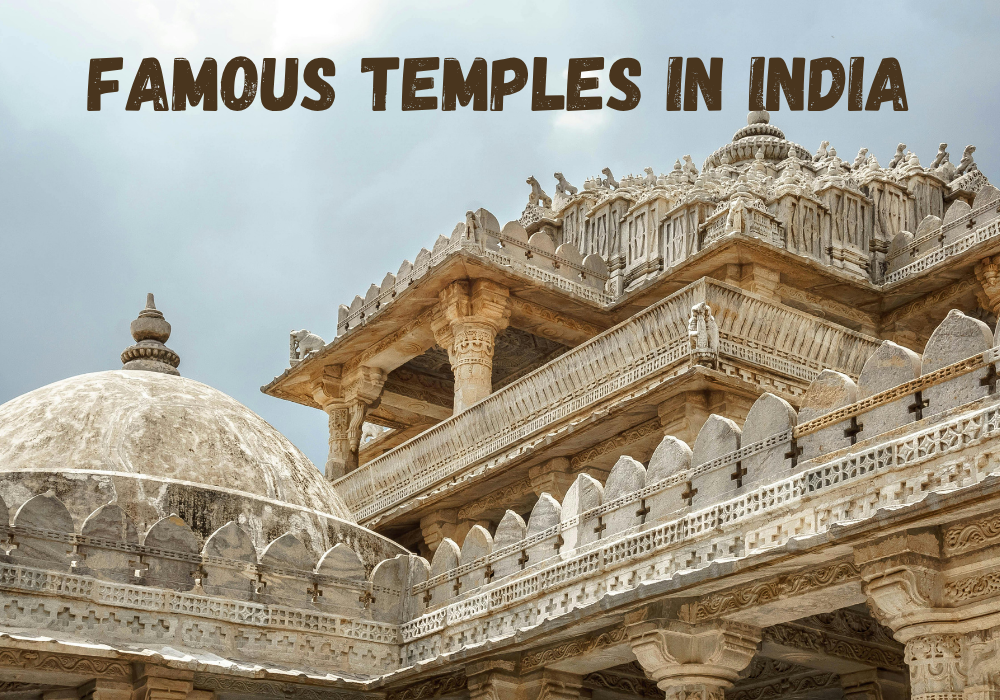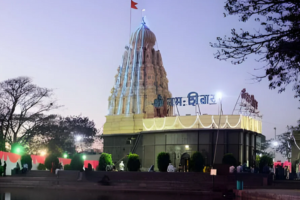
India, a land steeped in spirituality and ancient traditions, is home to countless famous temples in India that stand as testaments to centuries of faith, artistry, and devotion. From the snow-capped Himalayas to the sun-kissed southern coasts, these sacred sites offer not just a glimpse into India’s rich religious heritage but also an immersive experience of its diverse cultural tapestry. Join us on a captivating journey as we explore some of the most revered and architecturally magnificent temples across the country
Exploring the Famous Temples in North India: Himalayan Peaks to Sacred Plains
North India, with its majestic mountains and fertile plains, is dotted with a plethora of revered shrines that draw millions of pilgrims annually. These famous temples in North India are often associated with epic tales, profound spiritual significance, and breathtaking natural beauty. The spiritual aura of these regions is palpable, making every visit a deeply moving experience.
The Char Dhams and Beyond: Pilgrimage in the Himalayas
The Char Dham Yatra is perhaps the most famous pilgrimage circuit in North India, encompassing four highly sacred sites in the Garhwal Himalayas. Badrinath Mandir, dedicated to Lord Vishnu, is one of the four principal shrines and holds immense importance in Hinduism. Its serene location amidst the Neelkanth mountains adds to its divine charm. The temple’s ancient history and the belief in Lord Vishnu’s presence make it a focal point for devotees.
Kedarnath Dham, a revered Jyotirlinga of Lord Shiva, stands majestically amidst the Himalayas, accessible primarily after a challenging trek. Its ancient stone architecture and the raw beauty of its surroundings evoke a sense of profound devotion and awe. The stories of its origin and resilience against natural calamities only deepen its spiritual allure. Many pilgrims undertake this arduous journey seeking blessings and spiritual solace.
Gangotri Mandir, the source of the holy River Ganga, is another pivotal stop on the Char Dham circuit. Nestled amidst picturesque surroundings, this temple dedicated to Goddess Ganga offers a tranquil setting for prayer and reflection. The purity of the water and the spiritual energy of the place create an unforgettable experience for visitors. It’s believed that taking a dip in the holy waters here cleanses one of all sins.
Yamunotri Temple, dedicated to Goddess Yamuna, marks the source of the Yamuna River. Situated amidst the rugged terrain of the Garhwal Himalayas, it’s a site of immense spiritual significance. The trek to Yamunotri is challenging but rewarding, offering stunning views and a deep connection with nature. Pilgrims often take a dip in the hot springs nearby before visiting the temple.
Divine Mother and Ancient Shrines: Maa Vaishno Devi
The chant of “Jai Mata Di” echoes across the hills of Jammu, leading pilgrims to the sacred Maa Vaishno Devi. This cave shrine, dedicated to Goddess Vaishno Devi, is one of the most visited pilgrimage sites in India. Millions undertake the arduous trek to seek the Mother Goddess’s blessings, believing that she grants all wishes. The journey itself is an act of faith and devotion for many.
Bhairo Baba Temple, located near Vaishno Devi, is an essential part of the pilgrimage, as it’s believed that the pilgrimage is incomplete without visiting this shrine. This temple is dedicated to Bhairon Nath, a saint whose head is believed to have fallen here. It’s a testament to the intricate mythology and interconnectedness of these sacred sites.
Amarnath Dham Mandir, a natural ice Shiva Lingam in a cave in the Himalayas, is another profound pilgrimage for devotees of Lord Shiva. The challenging trek to this remote shrine is undertaken during a specific period each year, drawing hundreds of thousands. The sheer wonder of the natural formation and the deep spiritual significance make it an extraordinary destination.
Spiritual Hubs in the Plains: Vrindavan, Mathura, and Delhi
Vrindavan, a town steeped in the legends of Lord Krishna, is a vibrant hub of devotion. The Banke Bihari Temple Vrindavan is a prominent attraction, known for its unique darshan where the curtains are drawn and opened frequently. The playful nature of Lord Krishna is believed to reside here, attracting devotees from all corners of the world. The atmosphere in Vrindavan is always filled with chants and hymns. In Vrindavan, Maa Vaishno Devi Dham offers a serene spiritual experience, providing a dedicated space for devotees to seek the Mother Goddess’s blessings in the heart of Krishna’s land.
Mathura Temple, the birthplace of Lord Krishna, holds immense spiritual significance. The Krishna Janmabhoomi complex is a sacred site where devotees believe Lord Krishna was born. The city itself is filled with numerous temples, each with its own charm and story, making it a pivotal destination for Vaishnavites. Exploring Mathura offers a deep dive into Krishna’s early life.
Delhi, the capital city, is not just a political hub but also home to several significant temples. The Jagannath Mandir Delhi is a replica of the famous Puri temple and is a center for Odia culture and devotion in the capital. The Laxmi Narayan Mandir, also known as Birla Mandir, is a grand complex dedicated to Laxmi and Narayan, inaugurated by Mahatma Gandhi. Its modern architecture and serene environment attract many visitors. Delhi Temples refers to a collective of temples in the capital city, each offering a unique spiritual experience, from ancient shrines to modern marvels.
Architectural Marvels and Sacred Waters: Khajuraho and Dwarkadhish
Khajuraho Mandir, a UNESCO World Heritage Site in Madhya Pradesh, is renowned for its exquisite architecture and intricate erotic sculptures. While not primarily a pilgrimage site in the traditional sense, these temples are a testament to the advanced artistic and architectural prowess of ancient India. They represent a unique blend of spirituality and art. The details on the carvings tell stories of ancient Indian life and mythology.
Dwarkadhish Temple, located in Dwarka, Gujarat, is one of the all-India Char Dham pilgrimage sites and is dedicated to Lord Krishna, who is believed to have established his kingdom here. The majestic five-story temple with its elaborate carvings and towering spires is a sight to behold. Its coastal location and the tales of Krishna’s life make it a deeply revered destination. The city of Dwarka itself is steeped in mythology and ancient tales.
Unique Shrines and Spiritual Centers: Sai Baba Mandir and ISKCON Temples
Sai Baba Mandir in Shirdi, Maharashtra, is a revered pilgrimage site for devotees of Shirdi Sai Baba, a spiritual master. The temple complex attracts millions seeking blessings and solace, transcending religious boundaries. The teachings of love, compassion, and faith propagated by Sai Baba resonate deeply with his followers. Shirdi is a testament to the power of a spiritual leader to unite people.
ISKCON Temple in India, with its various branches across the country, represents the Hare Krishna movement. These temples, like the Hare Krishna Golden Temple, are known for their vibrant devotional atmosphere, beautiful deities, and outreach programs. They play a significant role in spreading the teachings of Bhagavad Gita and Vaishnavism globally. Each ISKCON temple offers a unique spiritual experience, often including prasadam distribution and kirtan.
The Hare Krishna Golden Temple (referring to ISKCON Bangalore’s unique golden structure) is a modern architectural marvel that combines traditional Indian temple design with contemporary elements, offering a unique devotional experience. It serves as a spiritual and cultural hub, drawing devotees and tourists alike. Its emphasis on global harmony and spiritual education is notable.
Hidden Gems and Local Legends: Mukteshwar and Devalsari
Mukteshwar Mahadev Temple, located in the Kumaon hills of Uttarakhand, is a serene Shiva temple offering panoramic views of the Himalayas. Its tranquil setting and spiritual ambiance make it a perfect retreat for those seeking peace and devotion. The surrounding natural beauty complements the spiritual experience. It’s a place where one can truly connect with the divine in nature.
Devalsari Temple, nestled in a serene valley in Uttarakhand, is a lesser-known but beautiful temple, offering a peaceful spiritual experience amidst nature. Its rustic charm and tranquil surroundings make it a hidden gem for those seeking quiet devotion away from the crowds. The local legends associated with the temple add to its mystique.
Discovering the Famous Temples in South India: Dravidian Grandeur and Ancient Lore
South India is a treasure trove of ancient temples, renowned for their distinctive Dravidian architecture, towering gopurams, and intricate sculptures. These famous temples in South India are not just places of worship but also living monuments to a rich cultural and artistic heritage. Each temple tells a story of devotion, architectural brilliance, and historical significance.
Tamil Nadu: Land of Towering Gopurams
Madurai Meenakshi Amman Temple, a masterpiece of Dravidian architecture, is dedicated to Goddess Meenakshi and her consort Sundareswarar (Lord Shiva). Its towering gopurams, intricate carvings, and vibrant halls make it one of the most stunning temples in India. The temple complex is a bustling hub of religious activity and cultural events, reflecting the vibrant traditions of Tamil Nadu. Its history dates back centuries, with numerous additions and renovations over time.
Kailasanathar Temple in Kanchipuram is one of the oldest structural temples in South India, known for its exquisite Pallava architecture and sandstone carvings. Dedicated to Lord Shiva, it offers a glimpse into the early period of Dravidian temple construction. The delicate artistry and historical significance make it a must-visit for enthusiasts of ancient Indian art. The temple’s unique design and the stories depicted in its carvings are truly captivating.
Sri Ranganathaswamy Temple in Srirangam, near Tiruchirappalli, is one of the largest functioning Hindu temples in the world, dedicated to Lord Ranganatha (a form of Vishnu). Its sprawling complex, numerous gopurams, and rich Vaishnavite traditions make it a significant pilgrimage site. The temple’s history is interwoven with various dynasties and their patronage, making it a living museum of South Indian history. It’s an architectural marvel with a vibrant spiritual atmosphere.
Ulagalantha Perumal Temple Kanchipuram is a unique Vaishnavite temple dedicated to Lord Vamana, an incarnation of Vishnu. It is significant for its association with one of the Divya Desams, the 108 Vishnu temples mentioned in the works of the Alvars. The temple’s architecture and the story of Lord Vamana’s cosmic stride are captivating for devotees and history buffs alike. Its ancient roots and the tales it holds contribute to its profound spiritual aura.
Ramar Padam Temple, while perhaps not as globally famous as some others, holds local significance, often referring to temples or shrines marking the footprints of Lord Rama, embodying his presence and journeys. Such sites are spread across India, particularly in regions associated with the Ramayana. These often serve as important local pilgrimage points and reminders of epic tales.
Thiruvairanikulam Temple is a well-known temple in Kerala, dedicated to Lord Shiva and Goddess Parvati. It has a unique ritual where the Goddess’s shrine is opened only for 12 days a year, attracting immense crowds during this period. This limited darshan makes it a particularly revered and sought-after pilgrimage for devotees in the region.
Andhra Pradesh and Telangana: Spiritual Hubs and Ancient Lore
Venkateswara Swamy Temple in Tirumala, Andhra Pradesh, is one of the richest and most visited temples in the world, dedicated to Lord Venkateswara (a form of Vishnu). Millions of devotees visit annually, seeking blessings and offering their prayers. The sheer scale of devotion and the temple’s intricate rituals are awe-inspiring. The temple is a significant economic and cultural powerhouse in the region. Its spiritual energy is palpable, drawing people from all walks of life.
“Kaleshwaram Temple” (specifically the Kaleshwaram Mukteswara Swamy Temple in Telangana) is a significant Shiva temple known for its unique location where two Shiv Lingams are found on one pedestal. It is a prominent pilgrimage site in Telangana, drawing devotees for its distinct spiritual significance and ancient history. The confluence of rivers nearby adds to its sacredness.
Vedadri Temple in Andhra Pradesh is dedicated to Lord Narasimha, an incarnation of Vishnu. It is situated on the banks of the Krishna River and is known for its serene atmosphere and historical significance. The temple’s association with the legend of Lord Narasimha makes it a revered destination for Vaishnavites. The natural beauty of the location enhances the spiritual experience.
Karnataka: Hampi’s Legacy and Golden Splendor
Hampi Temple (referring to the Vijayanagara Empire ruins in Hampi, Karnataka) is a UNESCO World Heritage Site, boasting a spectacular collection of ancient temples and monuments. The Virupaksha Temple is a prominent functioning temple within the complex, dedicated to Lord Shiva. The ruins themselves, including the Stone Chariot Hampi, tell tales of a glorious past and remarkable architectural ingenuity. The entire Hampi complex is an open-air museum, showcasing the grandeur of a bygone era.
The Stone Chariot Hampi, a marvel of Vijayanagara architecture, is a highlight of the Vittala Temple complex in Hampi. Carved out of a single piece of stone, it stands as a testament to the unparalleled craftsmanship of the artisans of that period. It’s an iconic symbol of Hampi’s rich heritage and a popular attraction for tourists and historians. Its intricate details and historical significance are truly remarkable.
Sripuram Golden Temple in Vellore, Tamil Nadu, is a relatively modern but stunning temple complex. Dedicated to Goddess Lakshmi, the temple’s main edifice is covered with 1.5 tonnes of pure gold, making it a truly dazzling sight. It’s a testament to contemporary devotion and artistic grandeur, attracting visitors for its unique beauty and spiritual ambiance. The sheer opulence of the temple is breathtaking.
Golden Temple Coorg (referring to Namdroling Monastery in Bylakuppe, Karnataka, a Tibetan Buddhist monastery often referred to as the Golden Temple due to its ornate golden structures) is a vibrant center of Tibetan Buddhism in India. While not a Hindu temple, it is a significant religious site and a major tourist attraction in South India, known for its grand architecture and serene atmosphere. It offers a unique cultural and spiritual experience.
Odisha: The Land of Jagannath and Lingaraj
Lingaraj Temple in Bhubaneswar, Odisha, is one of the most prominent Shiva temples in India, representing the pinnacle of Kalinga architecture. Its towering spire and intricate carvings are a testament to the architectural brilliance of ancient Odisha. The temple is an active center of worship and a significant historical monument, drawing devotees and art enthusiasts alike. The spiritual energy here is profound, with daily rituals and festivals.
Jagannath Mandir (referring to the Puri Jagannath Temple in Odisha) is one of the most famous and revered temples in India, part of the Char Dham pilgrimage. Dedicated to Lord Jagannath (a form of Vishnu), its annual Ratha Yatra (chariot festival) is world-renowned, attracting millions. The temple’s unique deities and rich traditions make it a cornerstone of Odia culture and spirituality. The temple’s kitchen is also famous for its massive capacity to feed thousands of devotees daily.
Olasuni Temple, located in Odisha, is dedicated to Goddess Olasuni, a local deity. It is known for its annual fair (Olasuni Gumpha Mela) which attracts a large number of devotees. This temple represents the rich folk traditions and local religious practices that thrive alongside the grander temple complexes in India. It showcases the diverse forms of worship prevalent in the region.
Beyond the Mainstream: Diverse Temples and Spiritual Practices
India’s spiritual landscape extends far beyond the most famous pilgrimage circuits, encompassing a wide array of temples, each with its unique history, architectural style, and devotional practices. These temples, whether ancient or relatively modern, contribute significantly to the country’s spiritual fabric.
Jainism and Unique Architectural Styles: Ranakpur and Wagheshwar
Ranakpur Jain Temple in Rajasthan is an architectural marvel, renowned for its intricate marble carvings and 1,444 uniquely carved pillars. Dedicated to Adinatha, the first Tirthankara of Jainism, it is one of the most important Jain temples in India. Its sheer scale and artistic detail are breathtaking, making it a must-visit for anyone interested in Indian art and architecture. The play of light and shadow within the temple is particularly captivating.
Wagheshwar Temple Wagholi, located near Pune, Maharashtra, is a local temple dedicated to Lord Shiva. While perhaps not as globally known as some other temples, it holds significant importance for the local community. It often serves as a focal point for village life, festivals, and traditional practices, embodying the spiritual heartbeat of rural India. These local shrines often preserve ancient customs and beliefs.
Goddess Power and Ancient Wisdom: Kamakhya, Vishalakshi, and Durga
Kamakhya Temple in Guwahati, Assam, is one of the most revered Shakti Peethas and a significant tantric center. Dedicated to Goddess Kamakhya, it is unique for its worship of the yoni (vulva) of the Goddess. The temple attracts pilgrims from across India and beyond, especially during the Ambubachi Mela. Its distinct rituals and powerful spiritual energy make it a truly unique destination. The myths and legends surrounding this temple are deeply fascinating.
Vishalakshi Temple in Varanasi, Uttar Pradesh, is another significant Shakti Peetha, dedicated to Goddess Vishalakshi (a form of Parvati). Situated on the banks of the sacred Ganges, it is an essential part of the pilgrimage circuit in the holy city of Varanasi. The spiritual ambiance of Varanasi combined with the power of the Goddess makes it a profound experience. Devotees often combine a visit here with a dip in the Ganges.
Durga Temple Varanasi, while not a Shakti Peetha, is another important temple dedicated to Goddess Durga in the spiritual city of Varanasi. Its vibrant red color and the presence of numerous monkeys add to its unique charm. It is a popular spot for local devotees and tourists seeking blessings from the fierce yet compassionate Goddess. The daily rituals and prayers contribute to its lively atmosphere.
Lord Shiva’s Abodes and Southern Wonders: Neelkanth and Idagunji
Neelkanth Mandir, in Uttarakhand, is a prominent Shiva temple nestled amidst dense forests and mountains. It is believed to be the place where Lord Shiva consumed the poison Halahala during the Samudra Manthan (churning of the ocean). Its serene location and spiritual significance make it a popular pilgrimage destination, especially during Shivratri. The trek to the temple offers stunning views and a sense of tranquility.
“Idagunji Temple” (specifically the Idagunji Mahaganapathi Temple in Karnataka) is a famous Ganesha temple known for its unique standing idol of Lord Ganesha. It is a significant pilgrimage site in coastal Karnataka, attracting devotees seeking blessings from the Remover of Obstacles. The temple’s traditional architecture and serene surroundings add to its spiritual appeal. It’s a popular stop for those on pilgrimage in the region.
Modern Devotion and Community Centers: Iskcon Temple Goshala
ISKCON Temple Goshala (referring to a Goshala, or cow shelter, associated with an ISKCON temple) highlights the importance of cow protection and care within the Vaishnavite tradition. Many ISKCON centers operate Goshalas, where cows are revered and cared for, embodying the principles of compassion and sustainable living. These Goshalas often become an integral part of the spiritual experience for devotees, emphasizing the holistic approach of the Hare Krishna movement. They serve as educational centers as well, promoting traditional farming practices.
This comprehensive list, while extensive, merely scratches the surface of the countless famous temples in India. Each temple offers a unique blend of history, architecture, and spiritual energy, inviting pilgrims and travelers alike to explore the depths of India’s rich religious heritage. Whether you are seeking spiritual solace, marveling at ancient craftsmanship, or simply curious about India’s diverse culture, these temples provide an unforgettable experience.
Conclusion: The Enduring Legacy of India's Famous Temples
This comprehensive list, while extensive, merely scratches the surface of the countless famous temples in India. Each temple offers a unique blend of history, architecture, and spiritual energy, inviting pilgrims and travelers alike to explore the depths of India’s rich religious heritage. Whether you are seeking spiritual solace, marveling at ancient craftsmanship, or simply curious about India’s diverse culture, these temples provide an unforgettable experience.
The journey through these divine abodes reveals not just the architectural prowess of past generations but also the enduring faith that continues to shape the lives of millions. From the north to the south, these temples stand as silent witnesses to centuries of devotion and continue to inspire awe and reverence. Plan your spiritual journey today and immerse yourself in the profound beauty and serenity of India’s sacred spaces. For further reading, you can explore the rich history of temple architecture on Wikipedia’s page on Hindu Temple Architecture or delve into the various pilgrimage routes on Incredible India’s official tourism website.

Binu Lamba
Binu Lamba is a 29-year-old editor and fact-checker with 7 years of experience in travel content. He verifies all location details, hotel recommendations, and travel tips to ensure our guides are accurate, updated, and helpful for readers planning real trips.

AI Assistant
Our AI writing assistant supports the creation of travel content under strict human supervision. All AI-generated posts are thoroughly reviewed, fact-checked, and updated by our team to maintain trust and accuracy in our travel recommendations.

Wagheshwar Temple Wagholi: A Complete Guide
Located in the bustling area of Wagholi, Pune, the Wagheshwar Temple is a serene Shiva temple known for its tranquil surroundings and traditional architecture. This sacred site draws devotees seeking spiritual calm amidst urban life.

Mumbai Weather: Understanding the Climate in the City
When planning a trip to Mumbai or simply going about your daily activities, knowing the city’s weather is essential. Mumbai, located along the Arabian Sea,

Top Places to Visit in Gulmarg: A Complete Travel Guide
Gulmarg, located in the breathtaking Kashmir Valley, is a paradise for nature lovers and adventure seekers. Known for its snow-capped peaks, lush green meadows, and








